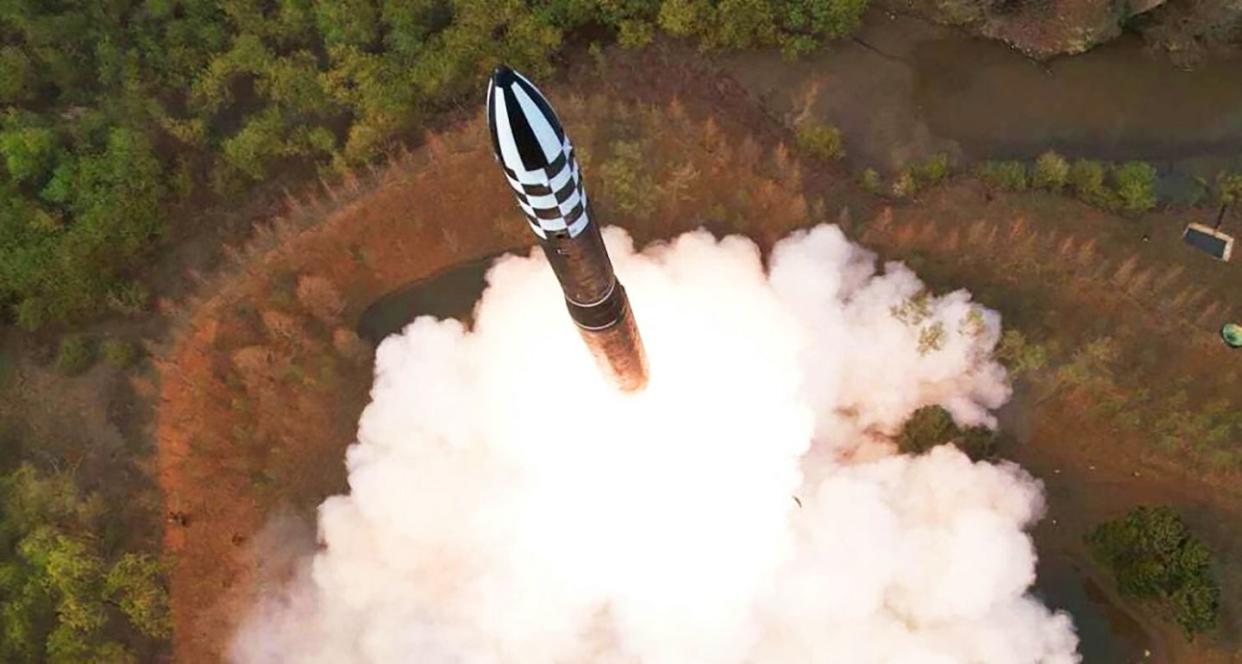North Korea Has Tested Its First Solid Fuel ICBM (Updated)

North Korea, which has been on an absolute missile-launching spree, has apparently tested its first solid-fuel intercontinental ballistic missile (ICBM), the Hwasong-18. The test marks a massive leap in capability for North Korea, which has been perfecting its missile technology since it began a rapid iterative testing campaign back in 2016 and has since restarted that testing after a period of questionable detente with the Trump administration.
The launch occurred yesterday, with images just being released now. Kim and his daughter, an increasingly present fixture at missile tests, were in attendance, as were his wife and his sister, the latter of which is also a key regime power figure.
KNCA
Also of interest is the fact that this missile appears to use the absolutely giant tube-carrying transporter-erector-launcher (TEL) we first saw at North Korea's military parade in February. At the time, we speculated this would house a solid fuel type. Kim's other ICBM types, the HS-14, HS-15, and HS-17, are not transported or launched from a canister.
A soft-launch appears to have been the way the missile safely exited the canister, which is an established initial pre-boost method for eastern strategic missile systems. The fact that the big TEL was used for this weapon also serves as another reminder that the days when Pyongyang showcased largely aspirational missile concepts are long gone.
KCNA
While North Korea has made major advances in solid fuel ballistic missiles over the better part of a decade, with short-to-medium range ballistic missiles, as well as submarine-launched types now using the technology, it is a real game changer for North Korean ICBM capabilities. That is if the prevailing analysis agrees that this was a solid fuel missile, which at this time seems very much to be the case.
One more image. Per North Korean state media, the test was meant to demonstrate a “nuclear counterattack” capability and to “make the enemies suffer from fear and anxiety.” pic.twitter.com/AVuPnDgxMK
— Ankit Panda (@nktpnd) April 13, 2023
Solid fuel allows for the missiles to far more quickly break from cover and launch — no long fueling period in an erect state is required. This means the missiles themselves are not nearly as vulnerable to preemptive strikes. It also drastically enhances North Korean response times and the fact that they appear to be pursuing silo-launch capabilities points to the possibility of something akin to a launch on warning deterrent arrangement in the future.
KCNA
Japan's Ministry of Defense said the missile flew just 621 miles on a steep trajectory as has been customary during long-range North Korean missile tests in recent years. This flight profile is used to keep the missile and its stages from crossing over foreign land masses.
While existing North Korean ballistic missile technology can reach the entirety of the United States, the reliability of its reentry vehicles and nuclear warheads remains in question.
KNCA
According to NKnews.com, the launch occurred on the grounds of one of Kim's elaborate private estates:
"The test took place at one of Kim Jong Un’s mansions that features a private golf course east of Pyongyang, according to Sam Lair, a researcher at the James Martin Center for Nonproliferation Studies (CNS) who geolocated the photos published in state media Friday.
NK News detected construction activity at the mansion starting between March 13 and 16, indicating preparations for the launch site were ongoing for around a month.
State media images show Kim and his daughter beside the missile on well-manicured lawns surrounded by newly-built ponds and berms, and soldiers walking the missile through a road tunnel and on roads likely inside his mansion compound."
This is a developing story we will update it with new information if it comes available.
Update—
Video has arrived:
VIDEO (2/3): North Korea's new state TV footage shows the Hwasong-18 solid-fuel ICBM launch.
Video shows it's cold-launched from TEL canister on top of a specially constructed, likely reinforced new garden area of a mansion compound near Pyongyang: https://t.co/6S0vcs4TL8 pic.twitter.com/1QEHWKVaq8— NK NEWS (@nknewsorg) April 14, 2023
Contact the author: tyler@thedrive.com

